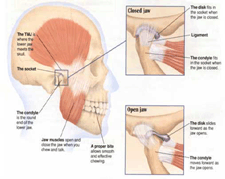المقالات
TMD

This cycle of pain, spasms, and joint imbalance can be started by clenching or grinding the teeth, a bad bite caused by missing teeth or poorly aligned teeth, a blow to the joint, arthritis or emotional stress.
Clenching and grinding will often go away once a person's stress is reduced. In the meantime, there are other ways to break this cycle. You can reduce muscle spasms and pain with:
To restore balance to the joint, we can crown teeth, fill spaces, adjust the bite using a procedure called equilibration, or even move teeth. A splint, which is a plastic mouthpiece, can reduce clenching and grinding, which will also help restore harmony to the joint. In extremely severe cases, surgery may be necessary to repair the damaged part of the joint.
Millions of people suffer from TMD. Treatment and lifestyle changes can break the TMD cycle and restore harmony to the joint.
The bones in the jaw Temporomandibular disorder, known as TMD, is a cycle of pain, muscle spasms, and joint imbalance where the jaw meets the skull. The lower jaw meets the skull at the temporomandibular joint, known as TMJ. This joint connects the temporal bone of the skull with the mandible bone of the jaw. Cushioning these two bones is a thin disc of cartilage. Five muscles support the joint.
